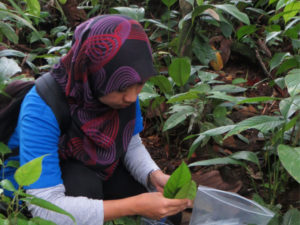
A new regional initiative is providing practitioners with tools for deciding where to focus conservation and restoration efforts.
The challenge: valuable tree species are under threat
Unsustainable extraction, along with changes in land uses and the climate, is threatening thousands of socioeconomically valuable tree species across Asia. These species urgently need conservation and restoration to help meet future needs for food, fuel and fiber in the world’s most populous region.
Yet, very little information is available about their historical and current distribution, patterns of genetic diversity, intensity of threats across their distribution ranges, or availability of seed sources to support restoration. Effective conservation strategies for these species and their genetic resources cannot be implemented without improving knowledge on the species’ distributions and the threats they are facing.
The solution: fill the knowledge gap
A new regional initiative is setting out to fill these gaps by producing up-to-date information on the distributions of valuable tree species and the threats to them, and guidance to develop conservation strategies that help maintain the genetic diversity and adaptive capacity of the species.
The Geographic Information for Conserving Native Tree Species and Their Genetic Resources in Asia-Pacific (APFORGIS) initiative is being coordinated by Bioversity International and implemented in collaboration with the Asia Pacific Forest Genetic Resources Programme (APFORGEN). The initiative contributes directly to APFORGEN’s new strategy for 2018-2022, which has named improving the availability and accessibility of species information as one of the network’s key objectives for the next five years.
50 pilot tree species
Tree species experts from across the region have identified 50 pilot species for APFORGIS, based on existing national priority species lists, socioeconomic importance and conservation status, and the diversity of species traits such as pollen and seed dispersal patterns, including:
- Kokum (Clusiaceae: Garcinia indica), widely used for its edible fruits, seed oil and medicinal values, and an important source of income for rural communities, but rapidly declining in the wild.
- Gamboge species which are dioecious (having separate male and female trees) – conservation guidelines need to consider sex ratios and larger than usual population sizes to avoid inbreeding.
- Borneo Ironwood (Lauraceae: Eusideroxylon zwageri), as its name suggests, is one of the most durable and heaviest timber species in the world, used for centuries for building ships, docks and houses fit for humid tropical conditions. Ironwood grows very slowly and its seed are dispersed mainly by gravity in the vicinity of the mother trees, making the species vulnerable for genetic erosion. Many anecdotes about the iconic species’ decline exist, yet it does not have an accurate conservation status or specific conservation strategies in place.
Methods, tools and capacities developed for these and other species can be used by forest departments, research institutions and conservation organizations for other species of interest with similar characteristics.
Knowledge to inform conservation strategies

“Current lack of knowledge about these and other pilot species illustrates the conservation challenges in the vast and extremely diverse Asian region,” says Riina Jalonen, who is coordinating the initiative.
“Thirty-seven percent of the pilot species have never been assessed for their conservation status despite of their socioeconomic importance, and another 31 percent were last assessed in the 1990s. Of the species assessed in the past 10 years, three-quarters are threatened.”
APFORGIS uses existing information about the species occurrences and threats to them to develop species distribution models. The models give an estimate of historical, current and potential future distributions. The resulting maps will be validated by experts and used for identifying conservation priorities. They can also be used to design and target field studies in the future.
Regional species distribution and threat maps developed by APFORGIS will help to:
- Identify centers of species diversity to optimize conservation efforts
- Assess how well the current protected areas cover the priority areas for conservation
- Identify areas where species populations may be most threatened by climate change
- Identify seed transfer zones and adequacy of existing seed sources for tree planting and forest restoration
- Plan studies on genetic diversity and provenance trials that are representative of the species’ range and the variation in environmental conditions
What’s next?
Based on up-to-date information about the species distributions and threats to them, the project will then develop guidelines for conservation units that maintain genetic diversity vital for the species survival, productivity and adaptive capacity. The units can also serve as sources of diverse and suitably adapted planting material, urgently needed for improving the success of forest restoration efforts.
Regional collaboration will allow countries share information and responsibilities in establishing and managing genetic conservation units. Fewer units are likely needed than if every country set up its own network, which helps to focus and sustain efforts over time.
The pilot species comprise:
|
|
|
To achieve conservation for the valuable tree species and their genetic diversity across Asia, the initiative needs help to gather information on the species’ known distributions, whether current or historical.
If you or your organization have data about the natural occurrences of the pilot species of APFORGIS, please contact Riina Jalonen r.jalonen@cgiar.org to find out how you can help.
Originally published on the website of Bioversity International.
Geographic Information for Conserving Native Tree Species and Their Genetic Resources in Asia-Pacific (APFORGIS) is a regional project implemented in Asian countries from December 2017 to November 2019. The project is coordinated by Bioversity International and implemented in collaboration with the Asia Pacific Forest Genetic Resources Programme (APFORGEN). The project is funded by the German Government through the Federal Ministry of Food and Agriculture. This research is part of the CGIAR Research Program on Forests, Trees and Agroforestry and is supported by CGIAR Fund Donors.











